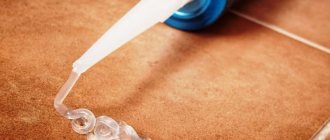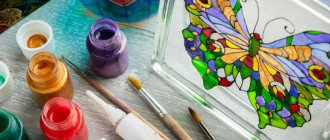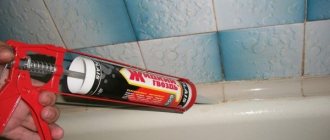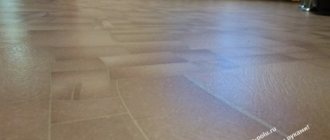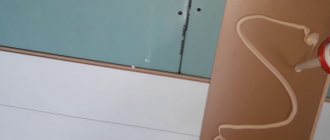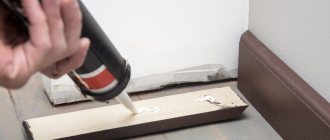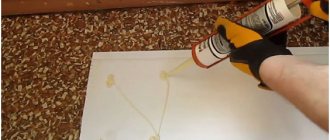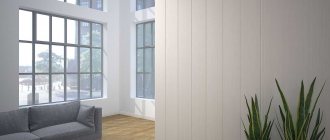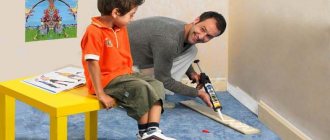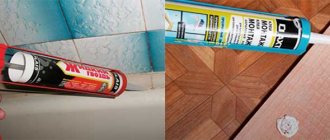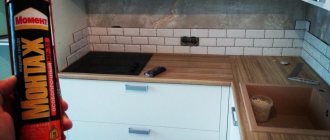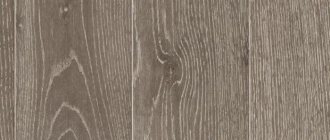What are liquid nails? What can you glue with them? Are these mixtures really capable of replacing conventional metal fasteners - “nails” and how to use them correctly? In this article you can find out the manufacturers' recommendations and other facts about this product, which is produced in a special package - a tube.
In 1968 American has released a new unique product - a universal construction adhesive mixture “Liquid Nails” (translated as “liquid nails”). For over 50 years, this building mixture has been in high demand in all countries of the world, fully justifying its name. Its practical application has confirmed the possibility of providing a high-quality connection of various materials, comparable in strength to mechanical strength.
ON A NOTE! At the moment, numerous modifications of this product are being produced, represented by other brands. Each of them has its own individual characteristics, which are important to consider when using. A detailed study of the instructions will help you understand all the nuances of how to use liquid nails.
Types of assembly adhesive
Before using the viscous mass, it must be said that today there are two main types produced: water-based and organic solvent. Its fixing properties, strength index and resistance to external factors depend on the chemical components.
With organic solvent
The main active component of the adhesive with an organic solvent was neoprene - chloroprene rubber. A mixture of this composition is excellent for joining glass and ceramic surfaces, as well as plastic.
Advantages:
- Ensuring increased strength of connections.
- Quick fixation.
- Preservation of properties under conditions of temperature changes down to -40 °C.
Flaws:
- Strong specific smell.
- Flammability in the liquid state does not allow the mixture to be used near fire sources.
- The toxicity of the components requires the use of the product in well-ventilated areas using gloves, respirators and other personal protective equipment.
With aqueous solvent
The main active components of water-based adhesives are acrylic paints, polyurethane and PVC.
Work methodology
In general, experts recommend removing glue residues from the surface of the cladding until they polymerize. However, if this does happen, it will be possible to cope with the task, although it is quite labor-intensive. Dried glue can be pryed off with fishing line or wire, but you only need to act on one side. The wire must be moved back and forth, grasping both ends. Thanks to this, the dried glue will begin to separate, and after that it can be lifted a few millimeters and a screwdriver or paper placed under the dried drop.
Pros and cons of the substance
Compared with other adhesive compositions widely used in installation, repair and various construction works, the substance is characterized by a number of advantages.
These include:
- increased degree of adhesion – several tens of times more reliable than analogues;
- versatility – can be used with almost all building materials;
- the ability to reliably connect surfaces of various structures: rough, glossy, etc.;
- quick clutch;
- sharing the substance with metal hardware;
- maintaining increased elasticity after drying;
- heat resistance (for organic-based glue);
- health safety (for water-based adhesive mixtures).
Main disadvantages:
- temperature barrier 0 °C (for water-based adhesive mixtures);
- toxicity, sharp specific odor (for organic-based adhesives).
HELPFUL ADVICE! To avoid problems during repair work, it is necessary to carefully familiarize yourself with the recommendations for the use of a specific type of solution, storage and application conditions. It is not recommended to store the cylinder in direct sunlight or in the cold. Storing the tube in a humid environment may cause the mixture to separate. The term of use is 1 year.
Safety
It is important to remember that some types of liquid nails are highly flammable. Therefore, during work it is necessary to ensure intensive ventilation. If the adhesive gets on the skin, it may cause irritation upon direct contact. If you feel dizzy during the installation of the panels, you need to go out into the air and, if possible, consult a doctor.
How to use liquid nails?
Application requires compliance with several important conditions. So, it is important to consider that water-based products are used at temperatures above 5 °C. When working with neoprene adhesives, it is necessary to ensure good ventilation of the room, use a mask and thick rubber gloves.
The surfaces to be bonded must be as dry and clean as possible. Glossy surfaces require preliminary degreasing, and porous surfaces need to be stripped of previous coatings (remnants of wallpaper, paint and primer). We recommend that you read the reviews: is it possible to degrease with white spirit and how long does it take for the primer to dry? Before using a fresh concrete surface as a base for gluing, you need to wait until it shrinks and dries.
Instructions for use
The main stages of fixing materials of various structures:
- Depressurize the tube - pierce it with a sharp metal object or make an incision on the plastic protrusion. Fix the plastic nozzle, cut off its end and seal with a cap until immediate use.
- When working, remove the cap and apply glue evenly to the back side of the part. To fix light elements, it is enough to put separate points; for long objects, a strip is applied, and for heavy ones, you will have to apply a mesh or snake.
- Press the part firmly onto the surface, locking it in the correct position. Hold with your hands for several minutes, applying slight pressure.
- Do not touch the surface until the glue has set. Primary adhesion takes up to 3 days, and complete polymerization occurs after a week. The speed of fixing parts depends on the temperature and humidity of the environment, as well as on the thickness of the layer. High humidity and low temperatures inhibit the hardening of the glue.
A different approach is used for gluing heavy materials (stone, bamboo wallpaper).
Description of PVC panels
The abbreviation PVC is a short form of the word polyvinyl chloride. The term refers to ordinary plastic material, plastic that has been shaped into the desired shape during the manufacturing process. For many years, PVC panels have been actively used as a finishing material, which has many advantages.
- Long service life without changing characteristics and appearance - 10 years or more, which is an excellent indicator for a finishing material.
- Easy to maintain - the panel is easy to clean from dust, it can be washed easily with any means (except abrasives).
- Environmental friendliness - modern PVC panels are being made from safe materials.
- Moisture resistance is one of the most important characteristics, thanks to which the panels can be used for finishing bathrooms, bathrooms, and other rooms where high humidity is noted.
- Fire safety – good quality panels, made in accordance with the technology, do not burn well and are non-toxic.
- Resistance to low and high temperatures, making the material suitable for finishing rooms for various purposes.
- Excellent level of sound insulation.
- The ability to attach to various surfaces – including concrete.
A huge selection of panel colors, with various designs and patterns. Such panels are great for quick and inexpensive repairs, but you should purchase them only from trusted suppliers who guarantee high quality products. Installation can be done at home yourself.
To avoid the need to soon repair or completely redo the finish, you need to pay serious attention to the choice of glue.
How to wipe off liquid nails?
Depending on how long ago it was applied and the type of surface, excess glue is removed in various ways.
How to remove the substance:
- uncured excess can be removed with a dry rag or knife;
- excess recently used glue is wiped off with a damp sponge.
It is much more difficult to get rid of frozen excess using:
- special cleaner;
- blade, scraper (on durable surfaces);
- by temperature influence, heating the adhesive residues to 70 °C with a hairdryer and cleaning them off with a scraper;
- on street structures, excess can be softened by sunlight and washed off with water;
- small fragments can be cleaned of excess by placing them in the freezer; the cracked product can be easily scraped off.
The substance is a universal construction adhesive for reliable fixation of surfaces made of various materials. Simplicity and efficiency of use makes it an indispensable tool for the home craftsman.
Additional recommendations
If there are small drops of glue left around the stain, they can be removed with a scraper, and then wipe the surface with a rag soaked in water. You can also use a certain amount of solvent for this. However, the cladding surface should not be damaged. Therefore, non-hazardous cleaning products should be used. Liquid nails for plastic are sensitive to temperature changes, so you can remove them after drying from the surface by heating a drop with a hairdryer or rubbing it with a piece of ice. This will remove small stains.
Which composition is better to choose?
When choosing the optimal option, it is necessary, first of all, to take into account the purpose of application. In particular, Henkel “Moment Installation” products have several varieties used for different types of work.
Basic recommendations when choosing:
- For facing work that involves fixing heavy materials (stone, siding, wooden panels, etc.), it is recommended to use high-strength “Heavy Duty”, “Especially strong installation moment”, “LN 901”, “Max Tack Sika”, “Zigger 99” and etc.
- Water-based solutions, for example, “Moment Installation Super-Strong”, are optimal for working with foamed materials (for example, polystyrene foam).
Summing up
Liquid nail glue can be used for all kinds of materials. It can be either foam or light plastic, or concrete. It is important to give preference to the appropriate manufacturer and type of product. When choosing glue, pay attention to where the work will be carried out, since not all such products are suitable for working outside the building, especially at air temperatures below zero.
Liquid nails are one of the simplest installation methods, which eliminates unnecessary holes and work with other tools, such as a drill. At the same time, the aesthetic appearance of the processed material does not change in any way.
Preparation: organizing the process
Primer: a must
Acrylic primer penetrates deeply into concrete and creates a binding and filling effect, increasing surface adhesion. Before attaching other building materials to concrete using an adhesive, it is imperative to prime the intended site. Covering with soil will help increase the adhesion of reinforced concrete. Protective agents differ according to the type of impact:
- Station wagon class. It is relevant to use for newly constructed structures.
- Deep penetrating agents. The preparations contain active molecules that, penetrating into the structure of the material, create a filling and binding effect. A widely used example is acrylic-based primers.
- Special silicate-containing. Chemical representatives from the polystyrene series. Due to high toxicity, they are used only for external work and industrial facilities.
Glue: material features
Plastic, drywall and any element can be attached to a concrete surface by gluing, using construction adhesive or other adhesive forms for concrete. The technology industry offers consumers a wide range of products and various appearances. The release form is dry, liquid adhesive for concrete; a new product in the construction industry, emulsion, is widely popular. Positively interacts with rubber, plastic and wood plywood. If you need to glue the material in an environment that often comes into contact with moisture and is subject to temperature changes, it is better to give preference to modifying agents.
